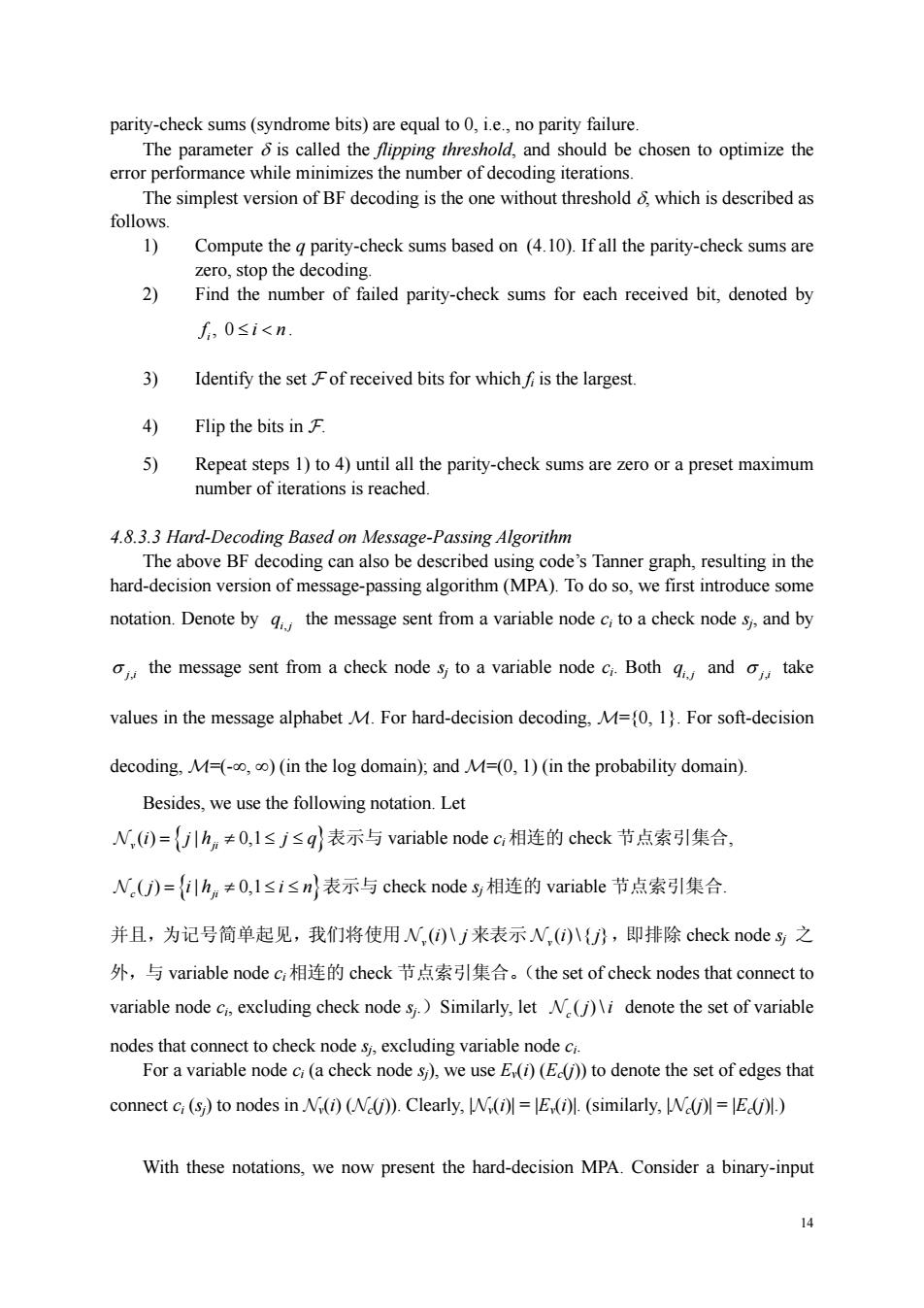正在加载图片...

parity-check sums(syndrome bits)are equal to0,i.e.,no parity failure. gthreshold,and should be chosen to optimize the The simplest version of BF decoding is the one without threshold o.which is described as follows. 1)Compute the g parity-check sums based on (4.10).If all the parity-check sums are zero.stop the decoding 2) Find the number of failed parity-check sums for each received bit,denoted by f人,0≤i<n 3)Identify the set Fof received bits for which f is the largest. Flip the bits in 5) Repeat steps 1)to 4)until all the parity-check sums are zero or a preset maximum number of iterations is reached. 4.8.3.3 Hard-Decoding Based on Messa e-Passing Algorithm The above BF decoding can also be described code's Tanner graph,resulting in th hard-decision version of message-passing algorithm(MPA).Todoso,we first introduce some notation.Denote by the message sent from a variable node c,toa check nodes and by the message sent from a check node s to a variable node c Both and o take values in the message alphabet M.For hard-decision decoding.M=(0,1).For soft-decision decoding.M=-,)(in the log domain);and M=(0.1)(in the probability domain). Besides,we use the following notation.Let N,()={hn≠0,1sj≤q表示与variable nodec相连的check节点索引集合 N.U)={hn≠0,lsi≤n表示与check node.号相连的variable节点索引集合. 并且,为记号简单起见,我们将使用N,()八j来表示N,()八{U},即排除check node.之 外,与variable node c,相连的check节点索引集合。(the set of check nodes that connect to variable node c excluding check node s)Similarly,let ()\i denote the set of variable nodes that connect to check node s.excluding variable node c. For a variable nodec(a check nodes)we useE()(E))to denote the set of edges that connect c(s)to nodes in()(N()).Clearly,=().(similarly,=) With these notations,we now present the hard-decision MPA.Consider a binary-input 14 14 parity-check sums (syndrome bits) are equal to 0, i.e., no parity failure. The parameter δ is called the flipping threshold, and should be chosen to optimize the error performance while minimizes the number of decoding iterations. The simplest version of BF decoding is the one without threshold δ, which is described as follows. 1) Compute the q parity-check sums based on (4.10). If all the parity-check sums are zero, stop the decoding. 2) Find the number of failed parity-check sums for each received bit, denoted by , 0 i f ≤ <i n . 3) Identify the set F of received bits for which fi is the largest. 4) Flip the bits in F. 5) Repeat steps 1) to 4) until all the parity-check sums are zero or a preset maximum number of iterations is reached. 4.8.3.3 Hard-Decoding Based on Message-Passing Algorithm The above BF decoding can also be described using code’s Tanner graph, resulting in the hard-decision version of message-passing algorithm (MPA). To do so, we first introduce some notation. Denote by i j , q the message sent from a variable node ci to a check node sj, and by σ j i, the message sent from a check node sj to a variable node ci. Both i j , q and σ j i, take values in the message alphabet M. For hard-decision decoding, M={0, 1}. For soft-decision decoding, M=(-∞, ∞) (in the log domain); and M=(0, 1) (in the probability domain). Besides, we use the following notation. Let Nv ji ( ) | 0,1 i jh j q = ≠ ≤≤ { }表示与 variable node ci相连的 check 节点索引集合, Nc ji ( ) | 0,1 j ih i n = ≠ ≤≤ { }表示与 check node sj相连的 variable 节点索引集合. 并且,为记号简单起见,我们将使用 ()\ v N i j 来表示 ( )\{ } v N i j ,即排除 check node sj 之 外,与 variable node ci相连的 check 节点索引集合。(the set of check nodes that connect to variable node ci, excluding check node sj.)Similarly, let ( ) \ c N j i denote the set of variable nodes that connect to check node sj, excluding variable node ci. For a variable node ci (a check node sj), we use Ev(i) (Ec(j)) to denote the set of edges that connect ci (sj) to nodes in Nv(i) (Nc(j)). Clearly, |Nv(i)| = |Ev(i)|. (similarly, |Nc(j)| = |Ec(j)|.) With these notations, we now present the hard-decision MPA. Consider a binary-input